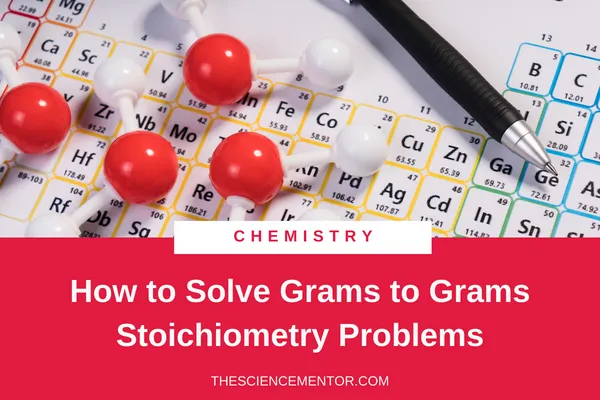My Blog
Tips, Resources, and Strategies for High School Science

How to Solve Grams to Grams Stoichiometry Problems
Stoichiometry is all about relationships. Specifically, between the reactants and products in chemical reactions. We use these relationships to convert from one substance/unit to another. For example, you may be given moles of A and need to convert to grams of B.
So, you may be converting both the Substance (NaCl, Fe, CO2)
Substance (NaCl, Fe, CO2)
Units (moles, grams, liters, particles)
The challenge is keeping up with the units. Well…actually the key to success is keeping up with the units. And since tracking each unit conversion is so important, always use a multiplication grid! That’s the T-chart looking thing that your teacher is always asking you to use.
Tips for solving stoichiometry problems:
Always have a balanced chemical equation!
Determine the given and what is being asked
Set up the multiplication grid – Put the given on the ‘front ledge’, and what you want to find behind the grid.
Make sure your given is in moles – If grams/liters/particles of A, convert the moles of A
Then continue conversions until you reach the units and substance asked for.
PRO TIP: Substance A must be in moles before converting to Substance B!
Want more info for each step? Here’s a video on mole to mole, mole to grams, and grams to grams conversion. It walks through each conversion with more detail.
Now, let’s use the steps to solve a problem.
Problem: If 48.5 g of barium chloride reacts in excess with silver nitrate, how many grams of silver chloride are produced?
2 AgNO3 + BaCl2 → 2 AgCl + Ba(NO3)2
Step 1: Always have a balanced chemical equation!
Our equation is balanced!
Step 2: Determine the given and what is being asked
We are given 48.5 g of BaCl2, and being asked to find grams of AgCl.
Step 2: Set up the multiplication grid – Put the given on the ‘front ledge’, and what you want to find behind the grid.
Step 3: Make sure your given is in moles – If grams/liters/particles of A, convert the moles of A
In this case, we have grams of BaCl2. So, we need to convert grams of BaCl2 to moles of BaCl2. To do this, we use molar mass. And we determine this using the periodic table. The molar mass for BaCl2 is 208.233 g/mol .
Notice that the molar mass is placed with the grams at the bottom and mole at top. This is to cancel out what we are given (grams), and convert to moles.
Step 4: Then continue conversions until you reach the units and substance asked for.
For this problem, we
Convert moles of A to moles of B (moles of BaCl2 to moles of AgCl)
Use the coefficients in the balanced chemical equation to find the molar ratio. There’s a 1 mole BaCl2 to 2 mole AgCl ratio.
Note the moles of BaCl2 are on the bottom. This is to cancel out BaCl2 and leave AgCl.
Convert moles of B to grams of B (moles of AgCl to grams of AgCl)
Use the periodic table to determine the molar mass of AgCl, which is 143.321 g/mol.
Check your final units. And you’re done!
Check out the above video if you want more details for each step.
All Rights Reserved 2023 - (C) TheScienceMentor.com -TM | Terms & Conditions | Privacy Policy | Disclaimers
